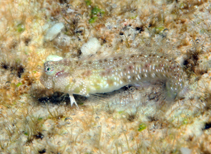| Family: |
Blenniidae (Combtooth blennies), subfamily: Salariinae |
| Max. size: |
5 cm TL (male/unsexed) |
| Environment: |
reef-associated; marine; depth range 0 - 8 m |
| Distribution: |
Indo-West Pacific: East Africa to Rotuma, north to the Ryukyu and Bonin islands, south to Rowley Shoals and the Great Barrier Reef. Recently recorded from Tonga (Ref. 53797). |
| Diagnosis: |
Dorsal spines (total): 12-12; Dorsal soft rays (total): 16-17; Anal spines: 2-2; Anal soft rays: 18-19. Has a distinctive black bar across the chin and a dark spot on each side of the gill membrane just in front of the pectoral base. |
| Biology: |
Adults are found in pairs or in small groups in dead reefs with algal turf (Ref. 90102) and in mixed coral and sand areas of clear outer lagoon reefs (Ref. 9710). Oviparous. Eggs are demersal and adhesive (Ref. 205), and are attached to the substrate via a filamentous, adhesive pad or pedestal (Ref. 94114). Larvae are planktonic, often found in shallow, coastal waters (Ref. 94114). |
| IUCN Red List Status: |
Least Concern (LC); Date assessed: 27 March 2009 Ref. (130435)
|
| Threat to humans: |
harmless |
Source and more info: www.fishbase.org. For personal, classroom, and other internal use only. Not for publication.
